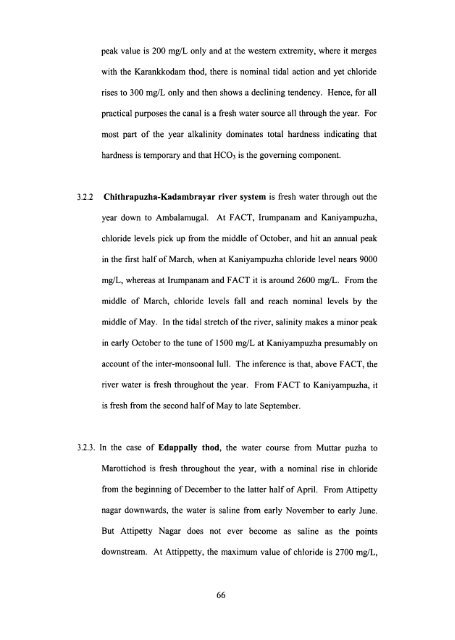Salinity Intrusion and Seasonal Water Quality Variations in the Tidal ...
Salinity Intrusion and Seasonal Water Quality Variations in the Tidal ...
Salinity Intrusion and Seasonal Water Quality Variations in the Tidal ...
Create successful ePaper yourself
Turn your PDF publications into a flip-book with our unique Google optimized e-Paper software.
peak value is 200 mg/L only <strong>and</strong> at <strong>the</strong> western extremity, where it merges<br />
with <strong>the</strong> Karankkodam thod, <strong>the</strong>re is nom<strong>in</strong>al tidal action <strong>and</strong> yet chloride<br />
rises to 300 mg/L only <strong>and</strong> <strong>the</strong>n shows a decl<strong>in</strong><strong>in</strong>g tendency. Hence, for all<br />
practical purposes <strong>the</strong> canal is a fresh water source all through <strong>the</strong> year. For<br />
most part of <strong>the</strong> year alkal<strong>in</strong>ity dom<strong>in</strong>ates total hardness <strong>in</strong>dicat<strong>in</strong>g that<br />
hardness is temporary <strong>and</strong> that HC03 is <strong>the</strong> govern<strong>in</strong>g component.<br />
3.2.2 Chithrapuzha-Kadambrayar river system is fresh water through out <strong>the</strong><br />
year down to Ambalamugal. At FACT, Irumpanam <strong>and</strong> Kaniyampuzha,<br />
chloride levels pick up from <strong>the</strong> middle of October, <strong>and</strong> hit an annual peak<br />
<strong>in</strong> <strong>the</strong> first half of March, when at Kaniyampuzha chloride level nears 9000<br />
mg/L, whereas at Irumpanam <strong>and</strong> FACT it is around 2600 mg/L. From <strong>the</strong><br />
middle of March, chloride levels fall <strong>and</strong> reach nom<strong>in</strong>al levels by <strong>the</strong><br />
middle of May. In <strong>the</strong> tidal stretch of<strong>the</strong> river, sal<strong>in</strong>ity makes a m<strong>in</strong>or peak<br />
<strong>in</strong> early October to <strong>the</strong> tune of 1500 mg/L at Kaniyampuzha presumably on<br />
account of<strong>the</strong> <strong>in</strong>ter-monsoonallull. The <strong>in</strong>ference is that, above FACT, <strong>the</strong><br />
river water is fresh throughout <strong>the</strong> year. From FACT to Kaniyampuzha, it<br />
is fresh from <strong>the</strong> second halfofMay to late September.<br />
3.2.3. In <strong>the</strong> case of Edappally thod, <strong>the</strong> water course from Muttar puzha to<br />
Marottichod is fresh throughout <strong>the</strong> year, with a nom<strong>in</strong>al rise <strong>in</strong> chloride<br />
from <strong>the</strong> beg<strong>in</strong>n<strong>in</strong>g of December to <strong>the</strong> latter half of April. From Attipetty<br />
nagar downwards, <strong>the</strong> water is sal<strong>in</strong>e from early November to early June.<br />
But Attipetty Nagar does not ever become as sal<strong>in</strong>e as <strong>the</strong> po<strong>in</strong>ts<br />
downstream. At Attippetty, <strong>the</strong> maximum value of chloride is 2700 mg/L,<br />
66

















